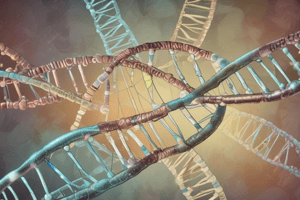Podcast
Questions and Answers
เอพิจเจเนติกส์เป็นการศึกษาเกี่ยวกับอะไร?
เอพิจเจเนติกส์เป็นการศึกษาเกี่ยวกับอะไร?
- การศึกษาพฤติกรรมของสัตว์
- กระบวนการการสืบพันธุ์ของสัตว์
- กระบวนการที่ทำให้กลิ่นของสัตว์เปลี่ยนได้
- การศึกษาถอดรหัสดีเอ็นเอของสัตว์ (correct)
การกำหนดเพศในมนุษย์คือกระบวนการของอะไร?
การกำหนดเพศในมนุษย์คือกระบวนการของอะไร?
- การส่งรหัสพันธุ์จากร่องเพศ (correct)
- การรับรู้กระบวนการของชีวิต
- การผสมพันธุ์ของสัตว์
- การพาการสื่อสารระหว่างเพศ
การแบ่งเพศในสิ่งมีชีวิตมักมีกระบวนการใดที่มีบทบาทในการกำหนดเพศ?
การแบ่งเพศในสิ่งมีชีวิตมักมีกระบวนการใดที่มีบทบาทในการกำหนดเพศ?
- พันธุกรรม (correct)
- อุณหภูมิ
- การห้อยโทหลัก
- สิ่งแวดล้อม
โครโมโซมไปรี้ถือเป็นอะไร?
โครโมโซมไปรี้ถือเป็นอะไร?
ใบ้ำพัด (Phenotypes) ของสัตว์แต่ละชนิดทำให้ไม่เหมือนกันด้วยอะไร?
ใบ้ำพัด (Phenotypes) ของสัตว์แต่ละชนิดทำให้ไม่เหมือนกันด้วยอะไร?
กรดอีนักลีคออกไซด์ (Deoxyribonucleic Acid) เป็นโครงสร้างอย่างไร?
กรดอีนักลีคออกไซด์ (Deoxyribonucleic Acid) เป็นโครงสร้างอย่างไร?
ข้อใดเป็นลักษณะสำคัญของยีน (gene)?
ข้อใดเป็นลักษณะสำคัญของยีน (gene)?
ลักษณะเช่นสีตาหรือความสูงของสิ่งมีชีวิตถูกกำหนดโดยอะไร?
ลักษณะเช่นสีตาหรือความสูงของสิ่งมีชีวิตถูกกำหนดโดยอะไร?
จุลชีพจำแจจำแจ ใช้ข้อมูลจากรุ่นพ่อและแม่ให้เด็ก ใช้ภูมิปัญญาใดในการคำถาม?
จุลชีพจำแจจำแจ ใช้ข้อมูลจากรุ่นพ่อและแม่ให้เด็ก ใช้ภูมิปัญญาใดในการคำถาม?
ถ้าเรามีการเปลี่ยนแปลงในลำดับของกรดอินิวคลียติด (nucleotides) ให้อ่าน TCGA เป็น TGGA จะเป็นผลกระทบต่อ__________.
ถ้าเรามีการเปลี่ยนแปลงในลำดับของกรดอินิวคลียติด (nucleotides) ให้อ่าน TCGA เป็น TGGA จะเป็นผลกระทบต่อ__________.
Study Notes
Unraveling the Threads of Heredity
Heredity, the process by which traits are passed from one generation to the next, has been a central topic in the pursuit of understanding life's complex patterns and the evolution of living organisms. From the tiniest bacteria to the mightiest blue whale, every living being inherits genetic information that shapes its characteristics and capabilities.
DNA: The Blueprint of Life
DNA (Deoxyribonucleic Acid) is the molecule that carries the genetic instructions for all living organisms. It's a long, twisted ladder-like structure made up of two strands, each consisting of a sugar-phosphate backbone and four types of nucleotide building blocks: adenine (A), cytosine (C), guanine (G), and thymine (T). The sequence of these nucleotides determines the genetic code that organisms use to build proteins and reproduce.
Genes: The Building Blocks of Traits
A gene is a specific segment of DNA that contains instructions for building a protein or regulating the activity of other genes. Each gene is responsible for a particular trait, such as eye color or height, and is inherited from the parent organisms.
Genes come in pairs, one inherited from each parent. Most traits are determined by multiple genes, and their combined effects contribute to the variation we see in the natural world. Environmental factors, such as diet, climate, and exposure to toxins, can also influence how genes are expressed, leading to more diverse phenotypes (observable traits) within a species.
Chromosomes: The Carriers of Genetic Information
Chromosomes are thread-like structures that carry DNA. In humans, we have 23 pairs of chromosomes, with one set inherited from each parent. Each chromosome contains thousands of genes, and the complete set of chromosomes is referred to as an organism's genome.
When cells divide, the DNA on the chromosomes needs to be accurately replicated and distributed to the new cells. The process of meiosis, which produces sex cells (such as sperm and eggs), ensures that each sex cell receives half the number of chromosomes as somatic cells (body cells), allowing for the mixing of genetic information between parents.
Sex Determination and Heredity
In most species, sex is determined by the combination of chromosomes inherited from the parents. In humans, males have an X and a Y chromosome (XY), while females have two X chromosomes (XX). Sex determination is not as straightforward in other species, with some organisms relying on temperature, genetics, or other factors to determine sex.
Epigenetics: The Study of Gene Expression and Heredity
Epigenetics is the study of how genes are turned on or off without altering their DNA sequence. Epigenetic changes can be influenced by environmental factors and can be passed on to future generations. These changes are not as permanent as genetic mutations but can have an impact on the expression of genes, leading to differences in phenotypes within a species.
The Power of Heredity Research
Understanding heredity has led to numerous scientific breakthroughs and practical applications, including:
- Advances in genetic medicine, which aim to treat diseases by correcting mutations in genes
- Developments in genetic engineering, which enable us to create new plant and animal varieties
- Improved understanding of the evolutionary processes that have shaped life on Earth
- Enhanced knowledge of species' genetic diversity, which can help us conserve and protect endangered species
Conclusion
Heredity is a complex and fascinating topic that continues to captivate scientists and researchers. By understanding the fundamental principles of heredity, we can better appreciate the intricate patterns of life and make informed decisions about the future of our planet. As research in this field progresses, we can expect to uncover even more about the mysteries of life and how the threads of heredity weave together to create the diverse and fascinating world we live in.
Studying That Suits You
Use AI to generate personalized quizzes and flashcards to suit your learning preferences.
Description
Test your knowledge on heredity, DNA, genes, chromosomes, and more with this informative quiz. Explore the fundamental concepts that shape our traits and characteristics through genetic inheritance.




